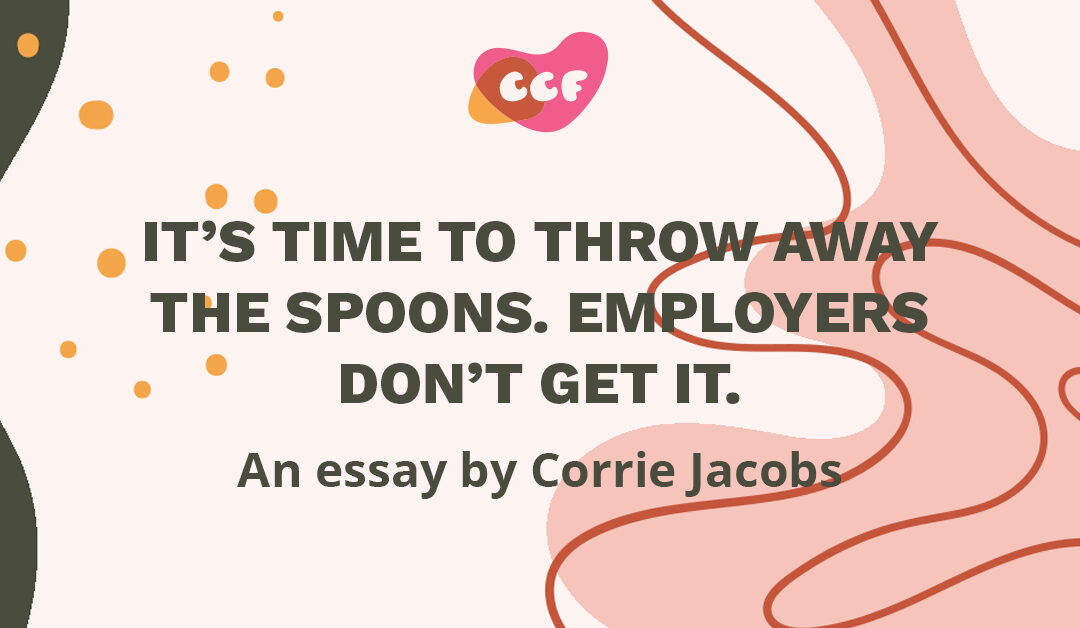By Corrie Jacobs, professional communicator and disability advocate
As a person with multiple invisible disabilities, I’m sick of explaining this theory. When you have service for 200 in your pocket, you’re probably not going to understand those who have to wait for their three spoons that are stuck in a rinse cycle.
If you know anything about the chronic illness and disability community, you’ve probably heard about spoon theory.
The basic idea is that everyone starts their day with a certain number of spoons, representing units of energy or effort. Non-disabled folx seemingly have an infinite number of spoons to make it through the day. People with disabilities and those living with chronic illness, AKA “spoonies,” have a limited number of spoons to use each day, which may also be impacted by how much their disabilities are impacting their functioning that day. Tasks may take one spoon or 10 spoons depending on how difficult they may be or how much energy we may have.
As a person with multiple invisible disabilities, I’m sick of explaining this theory. When you have service for 200 in your pocket, you’re probably not going to understand those who have to wait for their three spoons that are stuck in a rinse cycle.
It’s time to throw away the spoons. Let’s go with gas guzzlers instead. Surely the capitalist leaders of the world will get that more than tarnished silverware.
If my boss is a pickup truck with a 25-gallon tank, I am the first car I learned to drive in: my grandma’s 1990 Geo Prism with missing door handles, a window being held up with duct tape, no working AC, and an engine that could not exceed 70 mph. (Yup, and I loved that car like it was a traumatized stray cat found behind a dumpster.)
I’m generally running on empty, but let’s assume my 10-gallon tank is somehow completely full one day. Now, when I go to work, I have to be especially strategic about how I use those gallons in order to reach the same destination the pickup truck can reach with half a tank.
Does that mean I shouldn’t be allowed on the road at all? No. (A 2018 study found that hiring employees with disabilities will result in “countless benefits.”)
Does that mean I can’t reach my destination if I have to follow the rules of the road set by the impeccable pickup truck? Probably. And I’m probably going to break down a quarter of the way there.
And I hear you: Just drink more coffee!
Well, you need to find the right meds. Can’t you find a better doctor?
If you really care about your work performance, you would be participating in the free yoga program.
Invisible (and visible!) disabilities are not something we can magically wish away with a positive mindset, a miracle drug that doesn’t exist, or a gallon of caffeine. Nor should we want to wish them away.
You could ask yourself questions like, If I have an employee with a limb amputation, can I demand that they grow that limb back like a lizard tail? (The free yoga can help with that!) Are they going to get a “needs improvement” in their performance evaluation because the elevator is broken in your five-story building and they are late to meetings?
I hope that paragraph above sounds absolutely ridiculous to you. But all of the other messages I listed above in italics are things my employers have told me.
It’s almost 2024, y’all. Isn’t it time we fix this line of thinking? It really is no wonder that people with disabilities are almost twice as likely to be self-employed as compared to their non-disabled peers.
Rather than setting the rules of the road based on the pickup trucks – oh, those shining bastions of climate change – it’s time to make some improvements to the highway. Once you make those adjustments, here are just a few things you can expect:
1. Creativity and innovation
I can’t go 90 mph from San Francisco to LA with no breaks. But I can get from Point A to Point B in a way you’ve never thought about before. Oh, look, employees with disabilities bring new ways of thinking to your organization.
2. Diversity begets diversity
Your lack of stops may be a badge of honor, but when I’m at those rest areas, I’m engaging with people you didn’t even know existed. If you want to open up the diversity of your donor pool, client base, student population, or membership community, you need to hire people with disabilities. According to 2021 U.S. Census Bureau data, there 42.5 million Americans with disabilities. That’s 13% of the population. And that number is likely severely understated.
3. Employee loyalty and satisfaction, improved company culture, better reputation, all of the things!
If you modify a lane on your highway so that it offers private rest areas, institutionalized mentorship, quiet workspaces – or, you know, the flexibility to work from home and not have to pay the exorbitant cost of gas in the first place – you are going to see a lot more ROI from that than from the lunchtime meditation program and free popcorn machine (not to knock down either of those things, but a Friday nacho bar isn’t going to fix any of your deep-rooted personnel problems).
As a writer, I know I’m supposed to end this article with some pithy call-to-action that easily inspires you, makes you smile, and helps you feel good as you go about your day. Ha. I’d love to be able to do that for you!
What I can pithily say is: give us a damn parking spot in the executive lot already (or make it a safe enough space for those already in the lot to share their identities). Subsidize our trips to the mechanic. Let us skip the rush hour traffic, or better yet, stay home.
My 3.5-door sedan deserves to take up as much space as the freshly polished F-150.
We just may surprise you. I guarantee that our different perspectives are going to drive positive change for your organization.

Corrie Jacobs
Corrie Jacobs (she/her), who identifies as a disabled person, has been a communications professional in public education for the last decade. When she’s not fighting for disability and mental health awareness and equity in the workplace and the classroom, she’s keeping people cozy and building community among fiber artists through her business, Comma Craft Co.
If you want to connect with her about mentorship, workshop/speaking opportunities or something else, you can find her contact information via the Alt Ac Support Network.
If you want to help her fill up her gas tank, you can tip her via Venmo @CorrieJacobs or PayPal.
Discover more from CCF
Subscribe to get the latest posts sent to your email.

